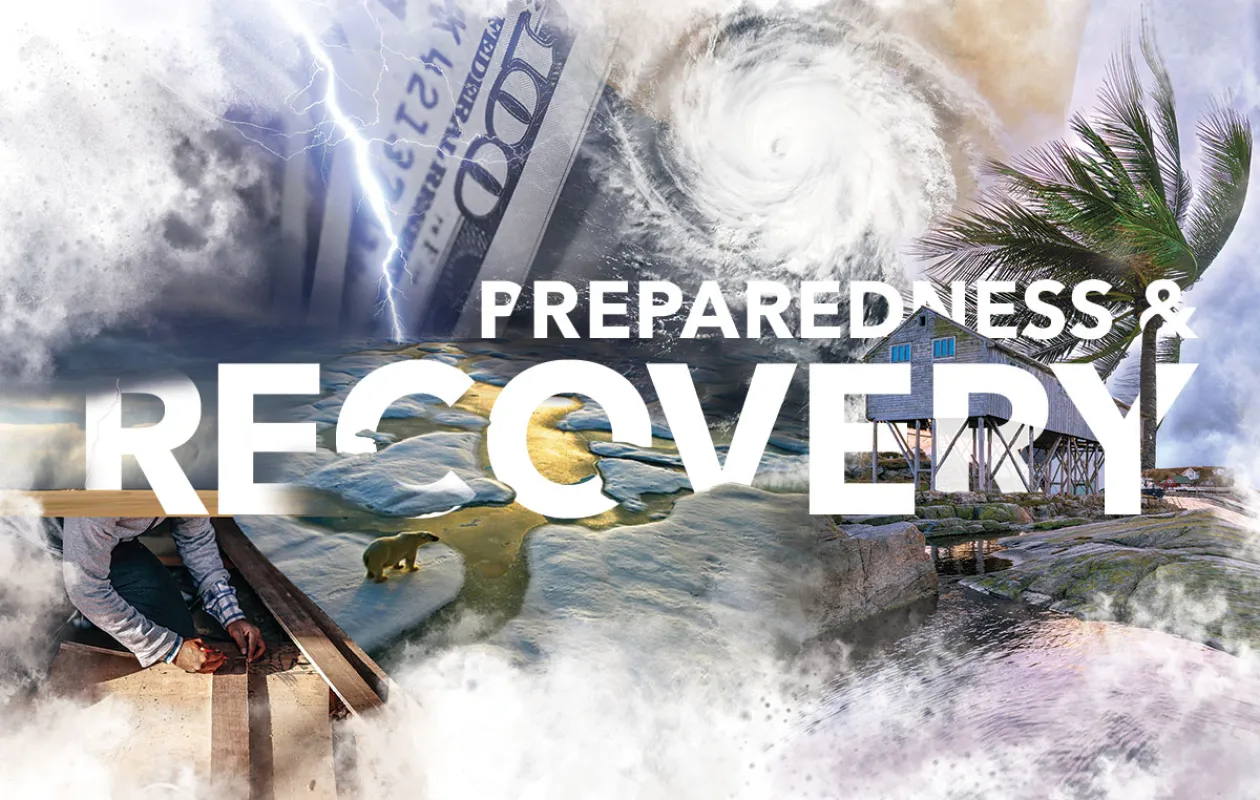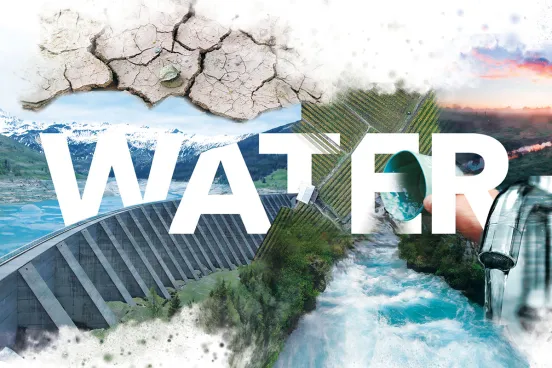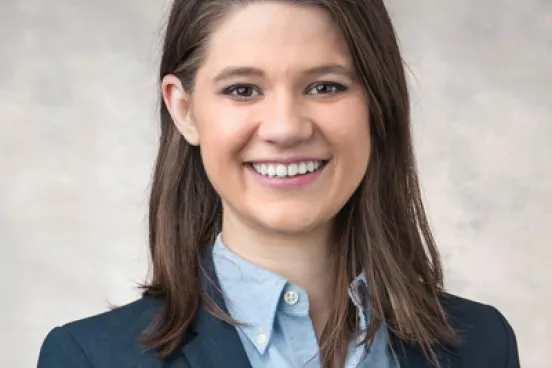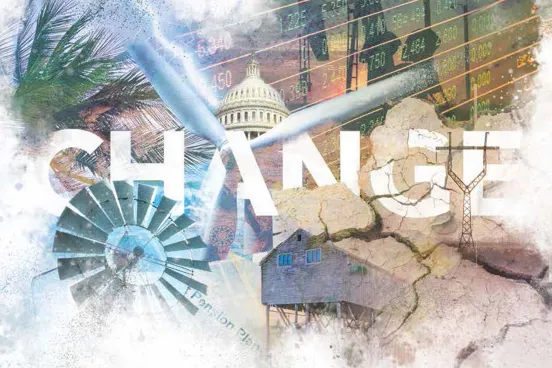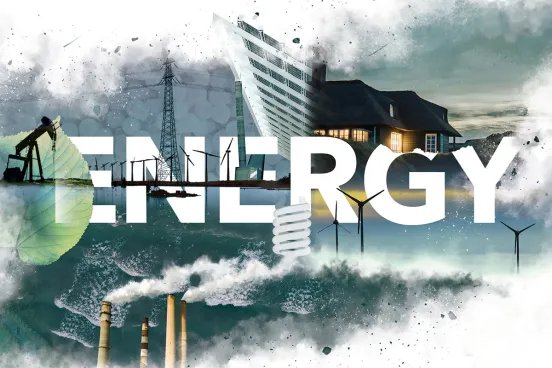As Hurricane Sandy bore down on the East Coast of the United States in 2012, Damon Vocke, ’89, stepped into his Connecticut yard with his two dogs, Winston and Diva. For Winston, it was business as usual—he seemed oblivious to the approaching storm. But Diva knew something was wrong. She was scared and wanted back into the house, where she then went to hide.
When it comes to the increasing frequency and severity of natural disasters and their underlying cause, one could argue that many Americans behave eerily similar to Diva and Winston. Some carry on under the belief that headline-gripping disasters could never happen to them. Others hope that the problem will go away. But to adapt to a world where the climate is going to differ dramatically from what it once was, preparation will be important.
Marty Myers, ’87, Partner, Covington & Burling LLP“Did the insurance industry assume some risks of climate change over the last 75 years? While governments and policymakers must address these risks now, the debate over who bears the cost of historical conditions may intensify in the coming years.”
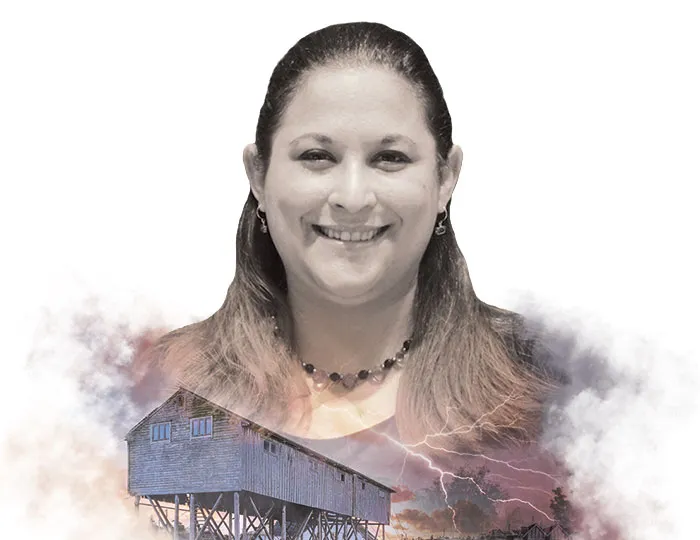
Thinking about disaster before the disaster
One of Michigan Law’s alumni, Victoria (Tori) Roth, ’12, works in the field of preparedness. Roth is an attorney-adviser at the Federal Emergency Management Agency (FEMA), in the Office of Chief Counsel for the Resilience-Preparedness and Continuity Legal Division (though the opinions she expresses in these pages are in a personal capacity and are not official statements on FEMA’s behalf).
“A lot of the attention and the money come after something bad happens,” she says. “It’s a struggle to get people’s attention before that moment because resources are scarce and there often is not as much political will to embrace preventative measures. But waiting until disaster strikes means waiting until it’s too late.”
According to Roth, FEMA recognizes the need to change that attitude, which is why the first goal of FEMA’s new strategic plan is to build a culture of preparedness.
Vocke had a front-row seat to disaster when Sandy hit. Called a “superstorm” because of its collision with cold Atlantic waters and cold Arctic air, as well as its extraordinary storm surge, Sandy was barely a Category 1 hurricane when it made landfall less than 200 miles from Vocke’s house, but it was a hurricane that packed a huge punch. It killed 106 people in the United States alone, rendered some 11 million people without power, suspended trading on the New York Stock Exchange for two days, crippled air travel throughout the country, and caused an estimated $65 billion in damage just in the United States. “It was far more devastating than I would have expected,” says Vocke of the storm’s aftermath. “We’re pretty close to the coast but not directly on it, and still, it was like a movie scene—an amazing amount of devastation. So I can only imagine a Category 3, 4, or 5 storm. The power of nature is just unbelievable.”
Of course, residents of New Orleans, Houston, the Florida coast, and the Caribbean don’t have to imagine those levels of storms—they’ve experienced them firsthand. In 2005, the Category 5 force of Hurricane Katrina and the ensuing breach of New Orleans’s levies put 80 percent of the city under water that was 20 feet deep in places.
At $161 billion in damages, Katrina holds the dubious honor of being the costliest storm in U.S. history, according to the National Oceanic and Atmospheric Administration (NOAA). Yet recent history seems to indicate that another disaster will challenge its top spot sooner rather than later.
Hurricane Harvey caused at least $125 billion in damages in the Houston area in 2017. The combination of that storm; the catastrophic damage to Florida, Puerto Rico, and the U.S. Virgin Islands from Hurricanes Maria and Irma; and the incinerating fires in California’s Napa, Sonoma, Mendocino, and Santa Barbara counties made 2017 the most expensive year on record for natural disasters—at an estimated $306 billion—according to NOAA.
So who pays for the damage?
As Vocke stood with his dogs in his yard, he was thinking about what was to come as a homeowner and family man, but also as a lawyer. “We all know that things like natural disasters, as unfortunate as they are, are going to happen periodically, with the potential for massive property damage losses, business interruption, and in the worst-case scenarios, even loss of life.
These kinds of events, along with the inevitable accidents that happen in daily life, and even our own mortality, give rise to the need for insurance products that assume financial risk to protect individuals and business enterprises from these kinds of unfortunate events.”
At the time of the storm, Vocke was global general counsel at General Reinsurance Corporation (Gen Re), which insures insurance companies, many of whom are household names. According to Vocke, “Reinsurance provides capital backstop for the insurance industry and also permits insurance companies to write a greater amount of business than they would be able to write with their own balance sheets.”
Today, he is a partner at Duane Morris LLP and has several insurance companies, including Gen Re, as clients. Some of his matters involve litigation and arbitration concerning whether his clients are obligated to pay claims that they dispute for a variety of reasons, including many related to climate change and its fallout.
As one example, he cites damage to or destruction of homes as the result of water events stemming from hurricanes. Personal homeowners’ policies cover damage from wind, but not from flooding. “But what about a storm surge caused by hurricane-force winds that wipes out coastal homes? Is that wind or water? In the aftermath of Katrina, there was a lot of litigation surrounding these questions,” Vocke says.
Vocke is adamant that the burden should be on policymakers to lead the charge in adapting to climate change, not on the insurance industry to pay the bills. “Insurance is a private industry that, as with any for-profit business, seeks to return a modest profit for its stakeholders.
This industry is also regulated to carefully evaluate risks, price them appropriately, and manage its exposures to ensure its ability to pay claims when they arise, and maintain financial solvency. It’s the only business I know of that sells a product whose costs of goods sold is unknown at the time of sale. Therefore, the industry will be both opportunistic, and very cautious, in assuming climate change-related risk exposures as they unfold in the coming years and decades.”
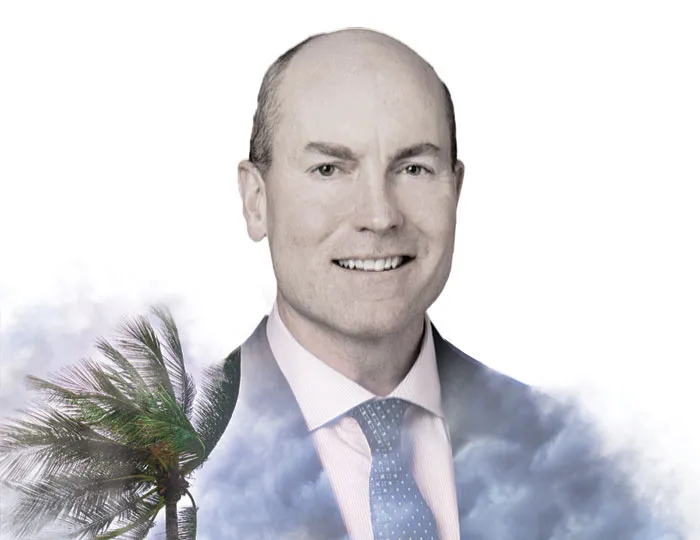
Growing urgency in the insurance industry
Although climate change presents a huge amount of potential exposure for insurance companies, the fact that most write contracts on an annual basis tempers the industry’s risk exposure at this time, he adds—and as the climate continues to change, the industry will adapt.
“The insurance industry will evolve, in terms of the products they offer, the pricing of those products, and what they are willing to cover as climate change becomes more understandable. There is a growing urgency within the insurance industry to do extensive research and to create partnerships to better understand climate change risk so that they can model it and try to understand how it will evolve and the scenarios to consider, and then work with government agencies on the policy decisions that need to be made.”
That cooperation with the government and other stakeholders also will shine a brighter light on insurance companies’ roles as investors, Vocke believes. Besides charging premiums and purchasing reinsurance, insurance companies (and reinsurance companies) invest heavily, just like citizens saving for retirement. As investments in the fossil fuel industry become more uncertain, for example, billions of dollars’ worth of assets—and the correlating ability to pay out claims—are at stake.
“There is growing concern that there should be, through policy and regulation, investment restrictions in those areas by insurance companies so that they aren’t putting their assets at risk,” says Vocke, noting that California-based insurers now are being asked to perform stress tests relative to their investments in the utility and fossil fuel industries.
Litigating climate change
As insurance companies shore up their ability to pay claims, environmental groups, municipalities, and states increasingly are calling for the companies whom they hold responsible for global warming to pay for the ensuing damages.
The cover of the May/June 2018 issue of the Sierra Club’s magazine reads, “It’s time the carbon barons paid for our unnatural disasters.” Big Oil is facing lawsuits from municipalities including San Francisco and New York City—which filed suit in January in the U.S. District Court for the Southern District of New York.
The complaint “seeks damages for the costs already incurred, and for actions the city currently is taking, to protect city infrastructure and property, and to protect the public health, safety, and property of its residents from the impacts of climate changes,” according to Hagens Berman Sobol Shapiro LLP, which is representing the City of New York.
The firm’s managing partner, Steve Berman, holds a bachelor’s degree from the University of Michigan. “The defendants knowingly continue their environmentally destructive behavior, seeking to shroud it with a sophisticated campaign to convince their consumers and the public that pervasive fossil fuel use is beneficial and environmentally responsible, and that defendants have misleadingly downplayed the risks of global warming with a campaign of denial,” the firm says.
It’s the next wave of climate change reparation litigation most famously represented by Kivalina v. ExxonMobil Corporation, et al, says Marty Myers, ’87, a partner in the insurance recovery practice at Covington & Burling in San Francisco.
“The first wave was largely unsuccessful, but the new groups of plaintiffs have retooled, studied the results, and re-evaluated their forum and strategic choices.” In 2008, the City of Kivalina, Alaska, sued business interests for up to $400 million to relocate the town inland.
The suit claimed that the defendants had contributed to the excessive carbon production that caused global warming, which, in turn, is responsible for the melting ice and rising sea levels that will render the town uninhabitable within a decade or two. In 2012, the U.S. Court of Appeals for the Ninth Circuit upheld the U.S. District Court for the Northern District of California’s dismissal of the case on the grounds that Kivalina’s federal common law claim of public nuisance was displaced by the Clean Air Act and Environmental Protection Agency regulations.
The U.S. Supreme Court declined to hear the case in 2013.
“Our conclusion obviously does not aid Kivalina…,” wrote U.S. District Court Judge Sidney Thomas. “But the solution to Kivalina’s dire circumstance must rest in the hands of the legislative and executive branches of our government, not the federal common law.”
One of the defendants in the Kivalina case was AES Corporation, a Virginia-based, Fortune 200 energy company that asked its insurer, Steadfast (part of the Zurich Group), to provide a defense and coverage under its commercial general liability policy. AES argued that Steadfast, and the insurance industry generally, assumed risks of climate change through general liability policies, which did not exclude such risks.
When Steadfast refused to cover, the case made its way to the Virginia Supreme Court, which upheld the lower court’s ruling in favor of Steadfast, in part because it found there was no occurrence or “accident” that triggered Steadfast’s duty to defend. Instead, the Virginia Supreme Court found that AES’s actions, which caused excessive carbon emission, were intentional, regardless of whether they were negligent.
Myers, who represents large-scale business interests attempting to recover insurance proceeds, says, “this next wave of climate change coverage litigation will involve the central question of what constitutes an accident, and whether or not courts outside of Virginia will view the answer differently in the years since the AES ruling.” Myers represents several large companies in the energy sector facing high-profile climate change-related litigation.
He is closely watching Liberty Surplus Insurance v. Ledesma & Meyer Construction, a negligent supervision case pending before the California Supreme Court with a similar “what constitutes an accident” question as AES Corporation.
“Insurance is very much a creature of state law, and Ledesma & Meyer may well give us a lot more data on how courts will construe coverage for climate change-related litigation,” Myers says.
Mitigating risk on both sides
Although they litigate on opposite sides of the courtroom, both Vocke and Myers say a big part of their jobs is to counsel their clients on risk management and how to, as Vocke says, “mitigate their exposures before the bad thing happens.”
For Vocke, whose clients are insurance and reinsurance companies, the focus is on writing policies that protect the insurers’ interests, with increasing consideration of the effects of climate change.
“There’s a greater discourse now by the insurance industry with their clients, particularly commercial clients, about risk management. It’s analogous to making sure that buildings you insure have a sprinkler system to protect against fire. How strong are the building materials? Where is the building located? Are you considering what will happen if there’s a six-inch rise in sea levels in the next 40 years?”
Meanwhile, Myers, whose clients include several large companies in the hospitality, oil and gas, and transportation infrastructure sectors, says a significant portion of his practice “involves advising clients on insurance placements and policy language to focus on specific anticipated risks.”
Heavy on that list of anticipated risks are those stemming from the effects of climate change, especially in coastal areas, and Myers works with clients to protect their businesses from multiple angles, including via flood insurance, general liability insurance, and property insurance.
For example, a coastal-area transportation facility client may require specific protection from future storms of particular magnitude and/or from rising sea levels that could cause flood or water intrusion damage. Directors and officers liability insurance also is part of the equation, as leaders of companies increasingly face public and shareholder pressure to disclose what they knew and when they knew it with regard to how their businesses were and are affecting the climate, and how they prepare for future potential losses.
“Boards of directors increasingly are focused on their companies’ exposures to climate risk from all angles,” Myers says. Myers also has been working with large environmental nonprofits exploring “parametric” insurance to restore natural resource areas like reefs, which may suffer specific impacts driven by climate change.
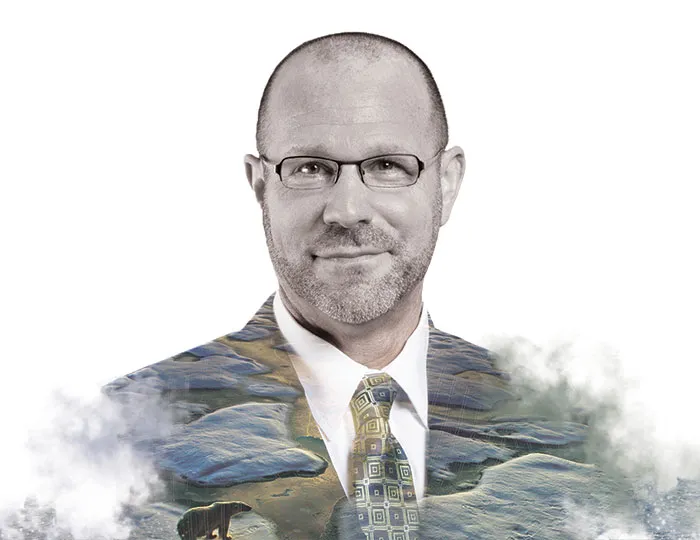
A seismic mindset shift
But clutching the appropriate insurance policies is only part of the equation. As climate change continues to increase the volatility of weather patterns and alter shorelines, Americans continue to face a moral hazard problem: People can get flood insurance to replace their homes in places that are flood prone. But how many times should a ruined house in a flood zone be rebuilt?
Within FEMA, the Federal Insurance and Mitigation Administration (FIMA) administers the National Flood Insurance Program (NFIP)—which Congress established in 1968 to provide relief for private insurance companies—under which FIMA issuses flood insurance policies for some five million Americans.
However, the program, operated bya different FEMA office and supported by a different legal division than the one where Roth works, is about $25 billion in debt according to the Congressional Budget Office, even after a $16 billion congressional bailout in October 2017. There have been efforts to privatize some of NFIP’s risk through reinsurance, “but the challenge is that the insurers have had some difficulty obtaining the data they need in order to intelligently analyze risks,” says Vocke.
“That’s a fundamental key to insurance: reliable loss data in order to determine your exposures and how much you should charge for them. But in addition to better data sharing, we must have basic policy reformation that addresses the recurrence of these coastal events. There hasn’t been enough of an incentive for seafront properties to purchase proper construction materials and to try to mitigate those risks from happening again.”
While FEMA garners headlines for its response to disasters and its administration of NFIP, Roth says the work her legal division supports, which focuses on preparedness and continuity of operations, is equally important. Her work focuses more directly on terrorism than on natural disasters, but says that in terms of the “all-hazards mission” of her daily work, the cause of the disaster is less important than the response. “We don’t get to choose what disaster will strike us next, whether it be a tornado, a hurricane, or a terrorist attack. My job is to help Americans be prepared for anything.”
In FEMA’s legal division for preparedness and continuity of operations, Roth is part of a team that advises FEMA staff who administer hundreds of grants totaling billions of dollars to help communities prepare for disasters, especially those stemming from terrorist attacks, among other preparedness purposes.
In October, as part of what she calls “an all-hands-on-deck situation,” she spent a month in Florida, helping communities understand the procurement rules for the grants they received in the wake of Hurricane Irma.
She has conducted trainings nationwide so that communities understand what resources are available in the wake of a disaster, and how to abide by the rules in obtaining and using federal grants. Understanding the applicable rules in advance of a disaster or even in the aftermath of a disaster, but before funds are expended, is part of a culture of preparedness that needs to permeate not just FEMA, but the entire country, Roth says.
“Instead of just focusing on disaster response and recovery, we also need to emphasize mindset shifts to focus on preparation. We need to get citizens more engaged and more aware of how to prepare for any situation. Usually the community and the victims themselves are the first responders, so it’s important for people who are directly impacted by any manmade or natural event to be prepared to help each other until those who traditionally are seen as first responders arrive.”
In this vein, Roth notes that “FEMA recently reorganized and created a new Resilience office in order to further promote a culture of preparedness. This new office encompasses FEMA’s various mission areas regarding flood insurance, mitigation, preparedness, continuity of operations, and grant programs. All of these elements are essential to building a more resilient nation able to respond to and recover from all hazards, regardless of cause.”
Readying communities for disaster also includes grants to mitigate the damage caused by rising sea levels.
One FEMA program can help homeowners elevate their homes on stilts; shoreline reinforcement is another commonly discussed mitigation measure.
But insurance is one of the foundations of recovery, Roth says. “Part of the culture of preparedness is encouraging citizens and businesses to have adequate insurance coverage. An insurance policy should be the first line of funding because the federal government cannot always step in. Disasters first are local issues, and then state issues; the federal government only provides grant funding or other assistance when the local, tribal, and state governments are overwhelmed, and only really when they request assistance.”


